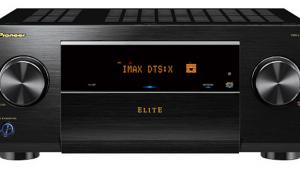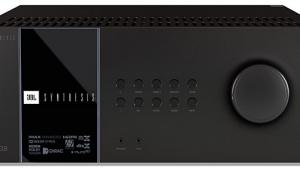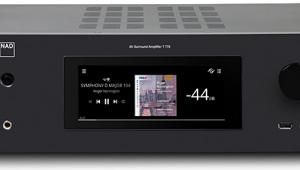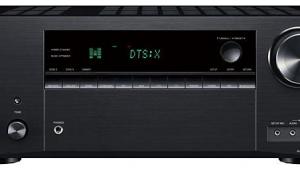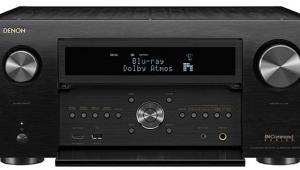Pioneer Elite VSX-72TXV A/V Receiver and Jamo A 7 Speaker System
It's a true testament to the international character of home theater, circa 2005, that so many of our Spotlight Systems include equipment from different countries—which usually provides a convenient opening angle in the process. Some of these worldly connections have been easier to make than others, and I already thought I was stretching things in our August 2005 issue by trying to come up with a compelling storyline for England and Japan. This time, I'm officially stumped. If you can come up with an introduction-worthy link between Japan and Denmark, then consider yourself truly educated in world affairs. I certainly like to imagine a band of Vikings and a band of Samurai trading blows on the battlefield, but, somehow, I don't think that ever happened. It's possible that these two countries squared off on a soccer field at some point, but I'd be the last person to know about that. Maybe this is finally a sign that I should stay more focused on what we're all really here for anyway—what these countries do when they get together in the listening room. Point taken.

Jamo is one of a few Danish speaker brands that have made headway on these shores. Unique styling and unmistakable aesthetic appeal have gained attention for the company, and their new A 7 speaker system will definitely add to that reputation. The second you lay eyes on it, you'll know why Jamo touts the speakers as plasma-TV friendly. But, considering that almost all current TVs are capitalizing on the silver-and-black motif, it's clear that this system will look outstanding arrayed around practically any recently made set.
The 2.5-way A 775 tower speaker anchored my system, pulling front and surround duty. This is a slick-looking floorstander that uses two 4-inch drivers—one as a midbass unit and the other for bass only—and a 0.75-inch tweeter in a svelte aluminum cabinet with a built-in base. (Jamo has made no concessions for mounting the A 775s on the wall.) Jamo has integrated the tweeter into the midbass driver. Jamo explains that this is a way to maintain the correct acoustic phase and keep the sound coherent and focused. Plus, the cabinets have a bass-reflex design with two internal cavities. I'm not a big fan of the binding posts on the A 775s. They're on the bottom of the base, they sit at a tricky angle, and they'll basically accept only bare-wire or pin terminations.
The A 7CEN is nicely matched to the A 775s. It's a horizontally aligned center channel that uses two 3.5-inch drivers, again in a midbass and bass-only setup, and the same 0.75-inch tweeter. As with the A 775, Jamo has integrated the tweeter into the midbass driver. The attached bracket will allow you to place the A 7CEN atop a TV set somewhat securely (a tabletop-base option would have been a welcome addition), but it's clearly intended for a wall-mounted arrangement. Its adjustability allows you to aim the speaker at various angles. Its binding posts are also limited in termination options and somewhat tricky to get to behind the bracket.
The A 7SUB is easy on the eyes, small, light, and easy to place. It uses a front-firing 10-inch woofer in a sealed cabinet with 200 watts of rated internal power. Its connections aren't entirely convenient, either, being on the bottom of the sub. The adjustable phase control (0 to 180 degrees) and crossover control (50 to 200 hertz) are on the bottom, as well, while the manufacturer has stylishly incorporated the gain control into the top of the sub. They have limited the inputs to a pair of line-level jacks, and there are no outputs. More importantly, there is no crossover bypass, which may be a problem if the crossover in your receiver or pre/pro cannot be defeated.
In addition to being a rock-solid performer, Pioneer's VSX-72TXV A/V receiver is a feature lover's dream—and that's no small thing in the receiver market. It's got everything we've come to expect from even midpriced receivers these days in terms of connections, including component video, ample digital and analog audio inputs and outputs, and audio and video for a second zone. You can also dedicate two amp channels to the second zone while you run a 5.1 setup in the main zone—always a bonus from a seven-channel receiver.
The VSX-72TXV has a good supply of the next level of connections, too, including a two-way RS-232 jack, an eight-channel analog input, and two HDMI inputs and an output (major bonuses on a receiver, especially at this price). Then there are the rarer tricks—namely an XM satellite input and an iPod input. With the former, all you need to do is connect the included XM antenna, get yourself a subscription, and you're ready to go with satellite radio. The latter naturally allows easy, direct access to the substantial music libraries that many people have built on their iPods these days. Both are smart additions and are sure to garner the VSX-72TXV some extra attention as people wade through the crowded receiver pool at the local A/V emporium.
The VSX-72TXV's highly impressive features list goes well beyond its connections. It also uses quality internal components, supplies all the latest processing (including EX, DPLIIx, and DTS 24/96), and is THX Select2–
certified. The advanced version of Pioneer's quality MCACC automatic calibration system is also aboard. This system does the basics, like setting speaker size, level, and delay, and it also employs a nine-band digital equalizer to perform room correction. The advanced mode goes further by attempting to distinguish between direct and reflected sounds for its adjustments, and it allows you to choose between using EQ on all of the channels or on everything except the front left and right. The advanced mode also makes phase adjustments and uses an X-curve process that seeks to account for psychoacoustic effects. The receiver performs all of these tweaks automatically with the supplied microphone, and you can adjust several of them manually, as well. Either way, MCACC is an impressive system.
As demo time rolled around, I was pleasantly surprised by what the A 775s were able to deliver from their limited cabinet dimensions. I found their soundstage to be a significant step up from some of the plasma-friendly-speaker competition. This isn't to say that it develops the kind of body and presence that a well-designed tower in a more conventional cabinet does, but it did seem to consistently get more than it should have been able to from its limited dimensions, especially in the lower frequencies. The A 775 does supply some punch and feeling of extension at the bottom end, although I would have liked to have heard more definition at times with music. I could say the same of the A 7SUB. It provides more thump than you would expect from a 10-inch woofer with 200 watts behind it, but I occasionally wished it could be tighter and quicker.
The system's bass was solid with movie soundtracks, with ample punch for the size and fewer indications of pace or definition issues than I would expect. And, speaking of movie punch, you get plenty of it in the surround field with the A 775s as surround speakers. I've always been partial to larger, more full-range surround speakers, even if they aren't as convenient as on-walls and the like. The A 775s are obviously direct radiators, but, in my room, some experimentation with placement and angle resulted in a noticeable reduction of localization cues and a surround stage that was relatively full and cohesive.
The A 7CEN is a good example of the fact that some manufacturers are doing a much better job of getting a warmer, more natural sound from metal materials such as aluminum. Dialogue, as well as lyrics with multichannel music, were accurate and intelligible, and music and surround effects came off nicely. Hollywood's overdriving of the center channel combined with the A 7CEN's tight dimensions and smallish drivers did occasionally result in some boxiness with movies and some compression when hard-driving dialogue, music, and surround effects were all active at the same time. But, once again, it is a more effective center channel with movies than many of its plasma-friendly speaker counterparts, and it proved to be more than capable with surround music, especially the high-resolution variety, of delivering a sense of warmth and naturalness.
Warm and natural would also be an appropriate description of the VSX-72TXV's performance. As with plasma-friendly speakers, you never entirely know what you'll get from midpriced receivers with music, as some appear to anticipate a predominance of movie duty and give music short shrift. I've never found that to be the case with Pioneer receivers, and it certainly isn't with the VSX-72TXV. Whether with stereo or multichannel tracks, its sound was effortless and balanced. This was especially impressive with big-bodied classical tracks that tax all five channels, such as the in-the-orchestra mix of Resphigi's Pines of Rome (DVD-Audio, AIX Records). It proved itself capable with both the easier-to-drive Jamos and more demanding loads like the B&W 803D speakers that I reviewed in the October 2005 issue. Granted, a $1,400 receiver is not the normal accompaniment to a five-figure speaker system, but the point was to see if the VSX-72TXV would get choked up or fatigued by a bigger, more demanding system—and the answer was a definitive no.
Do music right, and you'll usually do movies right—and we already know that the VSX-72TXV does music right. It banged out demanding movie tracks from the Lord of the Rings trilogy and Gods and Generals with the same general ease that it displayed with music, while supplying any number of different ways to listen to these movies. I added another set of surrounds to the Jamos and turned the LOTR movies loose with a DTS ES treatment that certainly left an impression. Dialogue was natural and unforced, surround effects were immediate and enveloping, and the music stole the show. The soundstage's seamless cohesiveness was a testament both to the VSX-72TXV's agility and accuracy, as well as to the accuracy of the MCACC system, as I ended up making only the slightest tweaks to the adjustments it made automatically.
When all was said and done, I was clearly impressed by my first go-round with a Japanese-Danish collaboration. Here are two old countries giving us a clear taste of what's to come in home theater's future—eye-popping aesthetics, considerable user friendliness and ergonomic appeal, and quality listening options and features. The system sounds good, too—and good sound is the best feature of all.
Highlights
Pioneer Elite VSX-72TXV A/V Receiver:
• Warm, inviting sound
• Has a truly impressive list of features and connections
Highlights
Jamo A 7 Speaker System:
• As beautiful to look at as we've come to expect from Jamo
• Requires less floor space than many tower-based systems
Need a Display?
We recommend the following displays to mate with this Pioneer/Jamo combo:
 Optoma H27 DLP Prpjector, $1,199
Optoma H27 DLP Prpjector, $1,199
Resolution: 854 by 480
Best video connection:DVI
Weight: 5.5 pounds
 NuVision NVX32HDU LCD HD Monitor, $2,499
NuVision NVX32HDU LCD HD Monitor, $2,499
Screen size: 32 inches
Best video connection: DVI
Weight: 46 pounds
**Please remember that if you decide to use a projector, you will also need to purchase a screen.
- Log in or register to post comments

